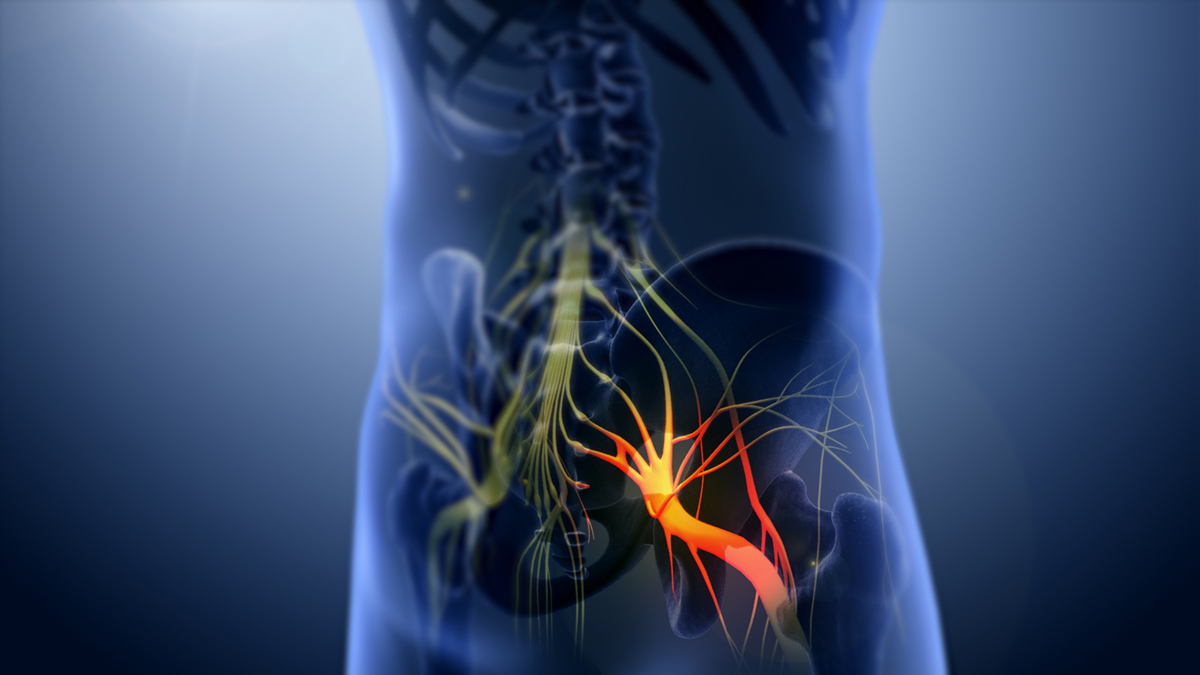
Definition of Sciatica
Sciatica is not a condition per se but it is more a set of symptoms all of which develop as a consequence of irritation/compression or complete damage to one of five sciatica nerve roots. Irritation of these nerve roots is associated with different changes in sensation as well as pain that radiates all the way down the nerve that is affected. So patients can basically complain about pain in the lower back or buttocks or even report painful sensation running down their leg even affecting the foot. In the majority of cases such pain affects only one side of the body.
The very term sciatic was first used in the middle of the 15th century. From then the approach to diagnosing sciatica has significantly progressed along with treatment which is today highly efficient in dealing with almost all symptoms and allowing patients to recuperate completely, regaining the lost strength and getting rid of all unpleasant changes in sensorium.
Causes and Symptoms
Sciatica develops as a result of irritation/compression of lumbar nerves L4 or L5 or even sacral nerves S1/S2/S3. The very sciatic nerve can be affected alone although this occurs in rare situations.
Firstly, the condition results from compression of a dorsal nerve root and is, therefore, many times classified as a lumbar radiculopathy. Such compression is related to a spinal disc bulge i.e. develops due to disc herniation. Most of the times the spinal discs are degenerated and it takes only a slightly inappropriate movement to make them bulge in the wrong direction, causing compression of the nearby nerve roots. The very disc comprises an annulus fibrosus, a firm ring of fibrous tissue surrounding the inner nucleus pulposus, a soft part that easily leaves the disc once any kind of tear occurs. So basically, the soft inner part of the disc moves from its original place and is blamed for irritation or compression of the affected nerves. This is the most common underlying cause of sciatica.
There is another condition called pseudosciatica, able to trigger practically the same symptoms of sciatica. However, unlike in actual sciatica, in people suffering from pseudosciatica there is a damage of facet joints in the lower back. The pain originating from these joints is easily interpreted as sciatica pain because it has the same characteristics as sciatica pain.
Finally, sciatica occurs in individuals who are suffering from lumbar spinal stenosis. If the spinal canal gets narrow, the one is soon likely to experience symptoms and signs of direct compression of the spinal cord and cauda equina. Sometimes there is even compression of sciatic nerve roots. Bone spurs, spondylolysthesis, inflammation of different structures in the spine etc are all to blame for lumbar spinal stenosis.
As far as symptoms of the condition are concerned, patients typically complain about pain that stays localized in the lower spine or onto the buttocks or radiates down the leg all the way to the foot. Such pain is described differently and may be sharp, in a form of burning sensation or sometimes excruciating, making one practically immovable. The pain intensity increases significantly with cough or sneeze as well as prolonged sitting or any activity that puts additional pressure to the already irritated nerve roots. Along with the pain, patients commonly report numbness and muscle weakness along the nerve pathway, tingling sensation or pins-and-needles sensation and in the most severe cases there is loss of bladder and bowel control resulting in incontinence.
Diagnosis and Treatment
A well experienced physical especially neurologist can easily diagnose sciatica without additional tests just by evaluating patient's medical history and performing physical and neurological exam. For instance, the doctor will use the straight leg rising test. Such test confirms sciatica if pain is reproduced when the patient's leg is moved up from the lying position. The leg must stay straight all the way the exam. The response of the body is in the form of severe pain, this signs is known as Lasègue's signs and easily confirms the presence of sciatica.
However, many times patients require additional tests and exams especially if there is no improvement of their condition within 6 weeks. CT scan MRI of the lumbar spine give perfect insight in tissue damage in the area and may be of major help when it comes to deciding whether one needs surgery.
The treatment is basically symptomatic, allowing the irritation to subside spontaneously and the nerve roots to recover on their own. Surgery is reserved for cases of direct and severe compression like in case of epidural abscesses, epidural tumors and cauda equina syndrome. As for medications, patients benefit most from pain killers, NSAIDs and muscle relaxants. The amount of bed rest and physical activity are also well determined where patients, after a certain period of time, must start being active usually through physical therapy. Relevant Statistical Data
Sciatica is rather disabling condition. According to data from the year 2006, the condition was blamed for 62% of cases of people missing work due to pain in the upper body. Furthermore, it is estimated that patients who deal with severe back pain for more than 6 months are highly likely to end up with chronic pain in the area.
The condition affects both genders and is more present in older individuals. Disability caused by sciatica is sometimes quite severe particularly if the condition reoccurs.
















-Causes,-Symptoms,-Diagnosis,-Treatment_f_280x120.jpg)
Your thoughts on this
Loading...